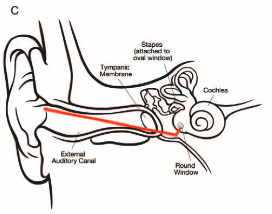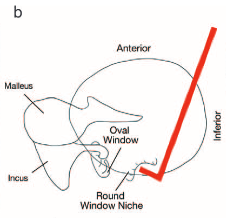Hello!
I am researching available options for imaging the inner ear for the purpose of studying and diagnosing inner ear pathologies, the cochlea in particular. It seems that existing technology is very limited in this respect. Unfortunately, the only way to study the human cochlea up-close is to use the cochlea of a dead person, or have the cochlea of a living person removed.
There is a technique where sound is used to test the cochlear function. This is based on Otoacoustic emissions (OAE) which were predicted by Thomas Gold in 1948 and demonstrated experimentally by David Kemp in 1978. This is probably the best technique we have right now for measuring inner ear health. However, I have read that this type of test is often inaccurate and the results are difficult to interpret. So are the results of this type of tests any more objective than simple audiograms? Have we not come any further since 1978?
It would be much better to be able to see healthy (or damaged) hair cells, rather than to hear them! Imagine having something like FMRI for the cochlea! Wouldn't that be something? Being able to peek inside the tiny cochlea of a living person non-invasively and having high resolution live view images displayed on a monitor, and seeing the vestibular, tectorial, the basilar membrane, and of course the stereocilia of hair cells in action? Is that kind of technology too much science fiction at the moment?
This may not give us a cure for tinnitus. But just imagine how much we could learn about the inner ear with a technology like that! A technology like that would give us the tool to answer many questions concerning inner ear pathologies and hearing disorders.
I am researching available options for imaging the inner ear for the purpose of studying and diagnosing inner ear pathologies, the cochlea in particular. It seems that existing technology is very limited in this respect. Unfortunately, the only way to study the human cochlea up-close is to use the cochlea of a dead person, or have the cochlea of a living person removed.
There is a technique where sound is used to test the cochlear function. This is based on Otoacoustic emissions (OAE) which were predicted by Thomas Gold in 1948 and demonstrated experimentally by David Kemp in 1978. This is probably the best technique we have right now for measuring inner ear health. However, I have read that this type of test is often inaccurate and the results are difficult to interpret. So are the results of this type of tests any more objective than simple audiograms? Have we not come any further since 1978?
It would be much better to be able to see healthy (or damaged) hair cells, rather than to hear them! Imagine having something like FMRI for the cochlea! Wouldn't that be something? Being able to peek inside the tiny cochlea of a living person non-invasively and having high resolution live view images displayed on a monitor, and seeing the vestibular, tectorial, the basilar membrane, and of course the stereocilia of hair cells in action? Is that kind of technology too much science fiction at the moment?
This may not give us a cure for tinnitus. But just imagine how much we could learn about the inner ear with a technology like that! A technology like that would give us the tool to answer many questions concerning inner ear pathologies and hearing disorders.

 Manager
Manager Member
Member
